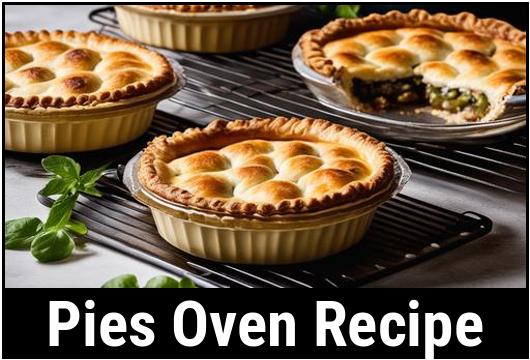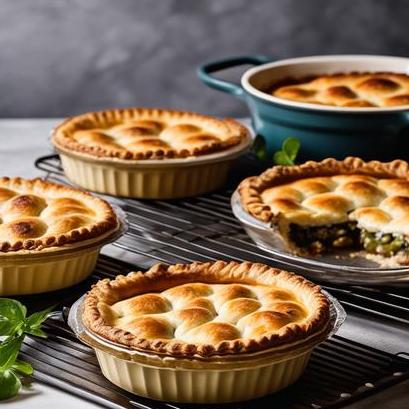- You are here:
- Home »
- Oven Recipes
- » The Art Of Baking Pies In An Oven

The Art Of Baking Pies In An Oven
Pie baking is the art that many amateur home cooks seek perfection in. Whether it’s a family gathering or an intimate dinner party at home, pies have always been the ultimate dessert. There’s something about the sweet aroma of pies baking in an oven that invites everyone in the room to take a seat and indulge in the sweet treat. But, in order to create the perfect pies, there are many things one needs to be aware of. So, let’s dive into the science of baking pies in an oven with this comprehensive guide.
Selecting Your Ingredients
Baking the perfect pie starts with selecting the right ingredients. The most important ingredients in a pie are the flour, butter, and sugar. It is best to use high-quality ingredients to achieve the best results. Always opt for all-purpose flour because it has just the right amount of gluten to create a light and flaky crust.
When selecting a butter, use unsalted butter because it allows you to control the amount of salt in the recipe. Sugar selection depends on personal preference – you can opt for brown sugar for a more caramelized taste or white granulated sugar for a more subtle sweetness.
Cleaning Your Kitchen
Once you have selected your ingredients, it is important to make sure your kitchen is clean before you start baking. Start by cleaning the countertops, cookware, and utensils. Wash all the utensils and cookware with warm soapy water and dry them off using a clean towel. If you are using a mixer, make sure it is also clean and dry before you start using it.
Preparing the Dough

Making the perfect pastry dough is crucial when making pies. Start by mixing the flour, salt, and sugar together in a bowl. Cut in the cold butter until the mixture resembles a crumbly consistency. Slowly add cold water, one tablespoon at a time, until the mixture forms a ball. Knead the dough lightly and then wrap it in plastic wrap. Chill the dough in the refrigerator for at least 30 minutes, or until it’s firm.
Rolling Out the Dough
Once the dough is chilled, it’s time to roll it out. Flour your work surface and your rolling pin. Place the dough on the floured surface and gently roll it out with the rolling pin. Make sure to keep the thickness of the dough even throughout. Roll the dough until it’s slightly larger than the size of the pie pan.
Assembling the Pie
Once the crust is ready, it’s time to add the filling. Use your desired filling, whether it’s apple, blueberry, cherry, or any other kind of pie. Add the filling to the crust and make sure it’s evenly spread out. Place the top crust over the filling and crimp the edges of the crust together to seal the pie.
Baking the Pie
Now that your pie is assembled, it’s time to bake it. Preheat the oven to 425°F (218°C). Bake the pie on the bottom rack of the oven for 15 to 20 minutes. Then, lower the temperature to 375°F (190°C) and continue baking for an additional 35 to 45 minutes. For best results, place the pie on a baking sheet or pie stone to ensure even baking.
Checking the Doneness of the Pie

It is important to check the doneness of the pie before taking it out of the oven. Use a toothpick or a cake tester to check if the filling is cooked through. Insert the toothpick into the center of the pie. If it comes out clean, the filling is cooked through. If it comes out with some filling sticking to it, continue baking for an additional 5 to 10 minutes until fully cooked.
Tips for a Perfect Pie
There are some tips that can help you achieve the perfect pie. Try these tips:
-
Use cold ingredients.
-
Don’t overwork the dough.
-
Chill the dough before rolling it out.
-
Always use a pie dish that has straight sides for a neat look.
-
Brush the top of the pie lightly with milk or egg wash for a glossy finish.
-
Place the pie in the fridge for around 15 minutes before baking to help the crust hold its shape.
Overcooking and Undercooking
Overcooking or undercooking the pie can ruin all your hard work. Undercooked pie can lead to a soggy or raw crust, while an overcooked pie can result in a dry and burnt crust. It is important to follow the baking times mentioned in the recipe and to keep an eye on the pie while it is baking. If you are unsure about the doneness of the pie, use a toothpick to test it as mentioned before.
Variations You Can Try
Pies come in various flavors and types. Not everyone likes a traditional apple pie, and there are several variations that you can try. Here are some ideas for you:
-
Blueberry Pie
-
Cherry Pie
-
Lemon Meringue Pie
-
Pumpkin Pie
-
Chocolate Cream Pie
-
Key Lime Pie
Recipe
Here is a simple yet delicious recipe that you can try at home:
Classic Apple Pie Recipe
Ingredients
-
2 and 1/2 cups (315 grams) all-purpose flour. Plus extra for dusting
-
1 Tablespoon granulated sugar
-
1 teaspoon salt
-
1 cup (225 grams) unsalted butter, cold and cubed
-
6-8 Tablespoons (90-120ml) ice-cold water
-
8 cups thinly sliced apples (about 6 medium sized apples)
-
3/4 cups (150 grams) white granulated sugar
-
2 Tablespoons unsalted butter, cut up into small pieces
-
1 and 1/2 teaspoons ground cinnamon
-
1/4 teaspoon ground nutmeg
-
1 egg mixed with 1 Tablespoon milk, for egg wash
-
coarse sugar for sprinkling over the top of the crust (optional)
Instructions
-
In a large mixing bowl, whisk together the flour, sugar, and salt.
-
Add the cubed, cold butter to the flour mixture. Using a pastry cutter or your hands, work the butter into the flour mixture until it resembles a coarse meal.
-
Drizzle 1 tablespoon of ice-cold water over the mixture. Use a spatula to mix the dough together, adding more water as needed.
-
Use your hands to shape the dough into a ball. Flatten the ball into a disk and wrap it in plastic wrap. Let the dough chill in the refrigerator for at least 2 hours, or overnight.
-
Preheat oven to 375°F (190°C).
-
On a floured work surface, roll out the chilled dough to a 12-inch circle. Transfer the crust to a 9-inch pie dish. Trim the edges so the crust fits the pie pan.
-
In a large mixing bowl, combine the sliced apples, sugar, butter, cinnamon, and nutmeg. Pour the mixture into the pie shell.
-
Lay the top crust over the filling or create a lattice top. Seal the edges of the crust together. Brush the top crust with egg wash and sprinkle with coarse sugar, if desired.
-
Place the pie on a baking sheet and bake for 50 to 60 minutes or until the crust is golden brown. If the edges start to brown too quickly, gently cover them with a piece of aluminum foil.
-
Remove the pie from the oven and let it cool for at least 20 minutes before slicing and serving.
In Conclusion
Baking pies in an oven may seem like a daunting task, but it is actually a simple and rewarding process. By following the preparation, selection, tips, recipe and variations mentioned in this guide, you can be assured that your guests will be impressed with your perfect pies. Remember, baking is all about practice and patience, so don’t be discouraged if your first pie does not turn out as expected. With time and patience, you will master the art of baking pies in an oven.
Sources
FAQS On Pies Oven Recipe
What Temperature Should I Preheat My Oven To When Making Pie?
When making a pie, it is recommended to preheat your oven to 425°F (220°C). This high temperature ensures that the crust becomes crispy and golden while the filling cooks evenly.
How Long Should I Bake A Pie In The Oven?
The baking time for pies can vary depending on the recipe and the type of pie. As a general guideline, fruit pies typically bake for about 45-60 minutes, while custard or cream pies usually require a shorter baking time of around 30-40 minutes. To ensure your pie is perfectly cooked, it is important to follow the specific instructions in your recipe.
Should I Use A Glass Or Metal Pie Dish For Baking?
Both glass and metal pie dishes can be used for baking pies, but they have slightly different effects on the crust. Glass dishes are known for producing a crispier crust, while metal dishes tend to create a darker, more golden brown crust. Ultimately, the choice between the two depends on personal preference. However, it is important to note that glass dishes may require a few extra minutes of baking time compared to metal dishes.
How Can I Prevent The Crust From Becoming Soggy During Baking?
To prevent a soggy crust when baking pies, there are a few techniques you can try. First, you can blind bake the crust for a few minutes before adding the filling. This involves placing the crust in the oven without any filling and baking it for about 10-15 minutes. Another method is to brush the bottom of the crust with beaten egg white or melted butter, which creates a barrier between the crust and the filling. Additionally, make sure to avoid overfilling the pie, as excessive moisture from the filling can contribute to a soggy crust.
How Do I Know When The Pie Is Fully Cooked?
One of the best ways to determine if a pie is fully cooked is by checking the appearance and consistency of the filling. For fruit pies, look for bubbling juices that indicate the fruit is cooked and the filling has thickened. Custard or cream pies should have a firm and set filling, which does not jiggle excessively when gently shaken. Additionally, the crust should be golden brown and crisp. It is also advisable to use a toothpick or a knife to insert into the center of the pie; if it comes out clean, the pie is likely cooked.


